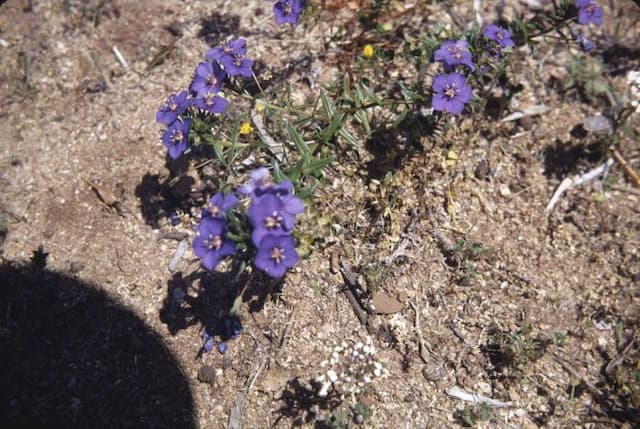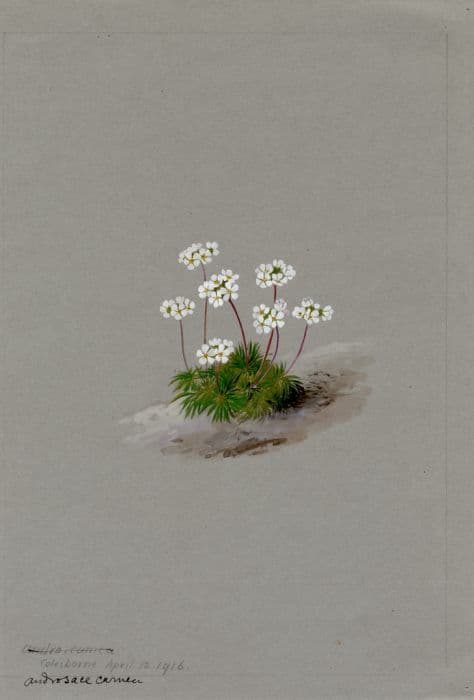Persian Cyclamen Cyclamen 'Sierra Scarlet' (Sierra Series)

ABOUT
Cyclamen 'Sierra Scarlet' is a vibrant and attractive flowering houseplant that is part of the Sierra Series. This plant is known for its striking scarlet red flowers that resemble shooting stars or fluttering butterflies due to their unique shape with upswept petals. The flowers emerge from a low-growing rosette of heart-shaped, dark green leaves that are often marbled with silver patterns on the top surface, adding to the plant's ornamental appeal. The foliage creates a lush and dense ground cover, providing a perfect backdrop for the vivid blossoms. At the center of the blooms, there is a contrasting mouth with a small eye that adds depth to the flower's coloration. The Cyclamen 'Sierra Scarlet' has a clump-forming habit, producing a tidy cluster of leaves and flowers that together form an attractive mound. The plant exudes an air of delicacy and elegance, making it a popular choice for indoor decoration.
About this plant
 Names
NamesFamily
Primulaceae.
Synonyms
Persian Cyclamen, Sowbread, Alpine Violet.
Common names
Cyclamen 'Sierra Scarlet'
 Toxicity
ToxicityTo humans
Cyclamen is considered toxic if ingested by humans. Eating any part of the plant can result in symptoms such as vomiting, diarrhea, and abdominal pain. In some cases, ingestion can also lead to heart rhythm problems or seizures if consumed in large amounts.
To pets
Cyclamen is toxic to pets if ingested. The most poisonous part is the tuber or root. Symptoms of poisoning in pets can include vomiting, diarrhea, salivation, and loss of appetite. In severe cases, it can cause heart rhythm abnormalities, seizures, and even death. Pet owners should seek immediate veterinary attention if their pet consumes any part of a cyclamen plant.
 Characteristics
CharacteristicsLife cycle
Perennials
Foliage type
Evergreen
Color of leaves
Variegated
Flower color
Scarlet
Height
6-9 inches (15-23 cm)
Spread
6-12 inches (15-30 cm)
Plant type
Bulb
Hardiness zones
9
Native area
Mediterranean
Benefits
 General Benefits
General Benefits- Vibrant Color Display - Cyclamen 'Sierra Scarlet' boasts bright scarlet flowers that add a bold splash of color to indoor and outdoor settings.
- Compact Size - With its small and compact form, it's ideal for container gardening and small spaces.
- Seasonal Interest - This cyclamen typically blossoms in late winter to early spring, providing floral interest during a time when few other plants are in bloom.
- Attracts Pollinators - The flowers can attract beneficial pollinators such as bees and butterflies when planted outdoors.
- Easy to Care For - Cyclamen 'Sierra Scarlet' is relatively easy to maintain with minimal care requirements, making it suitable for novice gardeners.
- Durable - It is a hardy plant that can withstand cool temperatures and short periods of frost.
- Long Blooming Period - Cyclamen 'Sierra Scarlet' has a lengthy blooming period compared to some other flowering plants, offering extended enjoyment.
- Decorative Foliage - Besides the striking flowers, it has attractive heart-shaped leaves with variegated patterns that provide visual interest even when the plant is not in bloom.
 Medical Properties
Medical Properties- This plant is not used for medical purposes.
 Air-purifying Qualities
Air-purifying QualitiesThis plant is not specifically known for air purifying qualities.
 Other Uses
Other Uses- Cyclamen can be used as a natural dye source for fabrics, with the petals imparting subtle hues to textiles.
- In the language of flowers, giving someone Cyclamen expresses love and sincere tenderness, making it a gift to convey deep emotions without words.
- Creative arts often incorporate Cyclamen blossoms to add vibrant colors to pressed flower projects, such as bookmarks or framed art.
- Edible Cyclamen flowers can be used as a decorative and slightly sweet addition to salads or as an elegant garnish on desserts.
- Plant enthusiasts may use Cyclamen in terrariums or fairy gardens, creating miniature landscapes with these colorful blooms as focal points.
- As a teaching tool, Cyclamen can be used to help students learn about plant biology, particularly bulb growth and dormancy cycles.
- The shape and structure of Cyclamen flowers can inspire artists and designers, influencing patterns in fashion, textiles, and other decorative arts.
- During holiday seasons, pot-grown Cyclamen provide festive decor, often outlasting traditional cut flowers due to their longer blooming period.
- Cyclamen petals can be incorporated into natural potpourri mixes, contributing to the visual appeal and adding a light, fresh fragrance.
- The plant's uniqueness and aesthetic appeal make it a popular subject for photographers and botanical illustrators focusing on the beauty of flora.
Interesting Facts
 Feng Shui
Feng ShuiThe Cyclamen is not used in Feng Shui practice.
 Zodiac Sign Compitability
Zodiac Sign CompitabilityThe Cyclamen is not used in astrology practice.
 Plant Symbolism
Plant Symbolism- Deep Love: Due to its vibrant red and heart-shaped leaves, Cyclamen commonly symbolizes deep love and devotion.
- Parting or Goodbye: In some cultures, Cyclamen represents departure or resignation, possibly because the plant dies back to its tuber after blooming and symbolizes a time of rest or separation.
- Sincere Affection: Offering Cyclamen as a gift conveys sincere feelings and affection towards someone.
- Empathy: Cyclamen's gentle appearance can represent empathy and care for another person’s emotional state.
 Water
WaterCyclamen, commonly known as Sierra Scarlet, prefer to be watered thoroughly whenever the top inch of soil feels dry to the touch. Typically, this means watering the plant with about 8 ounces of water for a smaller pot or up to a half-gallon for a larger container once every 7 to 10 days, but this can vary based on environmental conditions like temperature and humidity. It is crucial to water the soil directly and avoid getting water on the leaves or flowers to prevent issues with rot. During the dormant period (usually in the summer), reduce watering significantly, allowing the soil to remain drier.
 Light
LightSierra Scarlet Cyclamen do best in bright, indirect light; exposure to a few hours of morning light is ideal, followed by partial shade for the remainder of the day. They should be placed in a well-lit room but should be kept away from direct sunlight, which can scorch their leaves. East-facing windows are typically a good spot for Cyclamen to receive the appropriate amount of light.
 Temperature
TemperatureThe ideal temperature range for Sierra Scarlet Cyclamen is between 60 and 70 degrees Fahrenheit. It is important to keep the plant away from drafts or sudden temperature changes, as Cyclamen prefer a stable environment. They can survive in temperatures as low as 40 degrees Fahrenheit but should not be exposed to freezing conditions.
 Pruning
PruningSierra Scarlet Cyclamen benefit from periodic removal of yellowing or dead leaves and spent flowers to encourage new growth and maintain a tidy appearance. Prune as needed throughout the year, with a focus on tidying up the plant after blooming has finished. The best time for major pruning is in late summer before new growth begins with cooler fall temperatures.
 Cleaning
CleaningAs needed
 Soil
SoilPersian violet 'Sierra Scarlet' thrives best in a well-draining soil mix comprising peat, perlite, and potting soil, aiming for a slightly acidic to neutral pH of 6.5 to 7.0 for optimal growth.
 Repotting
RepottingPersian violets should be repotted annually in the dormant season, typically in summer when flowering ceases, to refresh the soil and accommodate root growth.
 Humidity & Misting
Humidity & MistingPersian violet prefers high humidity levels, ideally around 50-60%, but can tolerate a range from 40-70% without direct misting onto the flowers.
 Suitable locations
Suitable locationsIndoor
Place Persian violet in bright, indirect light with cool temperatures.
Outdoor
Keep in semi-shade, protect from hot sun and frost.
Hardiness zone
9-11 USDA.
 Life cycle
Life cycleCyclamen 'Sierra Scarlet', commonly known as Persian cyclamen, begins its life cycle when a seed germinates in a moist, well-draining growing medium in partial shade. The seedling develops into a small bulb-like structure called a corm, which then produces heart-shaped leaves and a sturdy stem. As it matures, the plant begins its flowering phase, usually in the fall or winter, producing vibrant red flowers atop long stems that rise above the foliage. After the flowering phase, the plant enters a dormancy period in the late spring and summer where it appears to die back, but the corm remains alive underground. During dormancy, it's essential to reduce watering to prevent rot. As temperatures cool and moisture increases with the onset of autumn, the cyclamen will break dormancy, regenerating its foliage, and start the cycle anew with another flowering period.
 Propogation
PropogationPropogation time
Spring-Early Summer
Cyclamen 'Sierra Scarlet', more commonly known as cyclamen, is often propagated by seed rather than vegetative means, as it can be challenging to divide the tubers without damaging the plant. The most popular method of propagation for cyclamen is through sowing seeds, which is typically done in the late summer or early fall. Fresh seeds are sown on the surface of a well-draining seed-starting mix and covered with a thin layer of the same mix or fine-grade vermiculite to maintain moisture. You should keep the temperature between 65 to 68 degrees Fahrenheit (about 18 to 20 degrees Celsius) and provide indirect light. Germination can take several weeks to a few months, and once seedlings develop true leaves, they can be carefully transplanted into individual pots. It's a slow process, but with patience, it leads to the growth of new cyclamen plants that will eventually flower, often in their second or third year after sowing.









